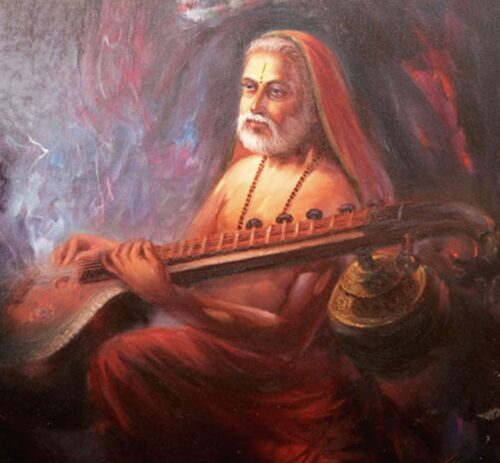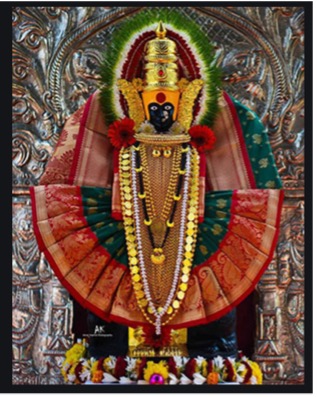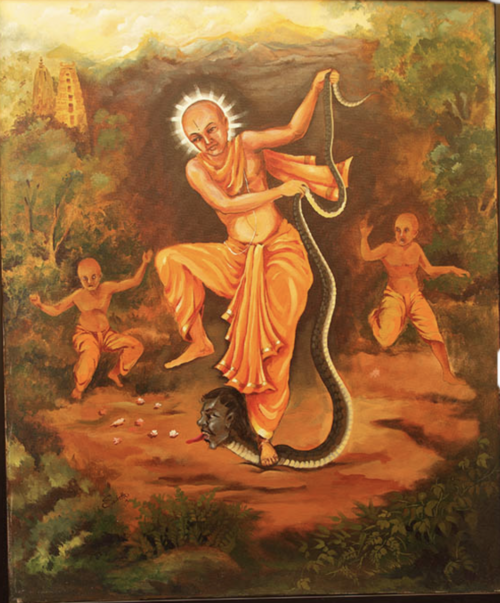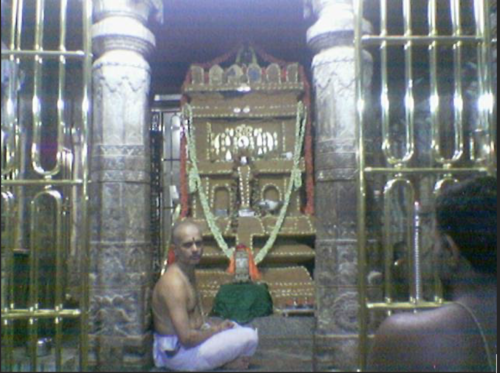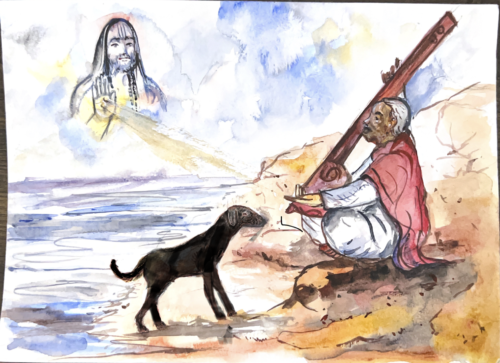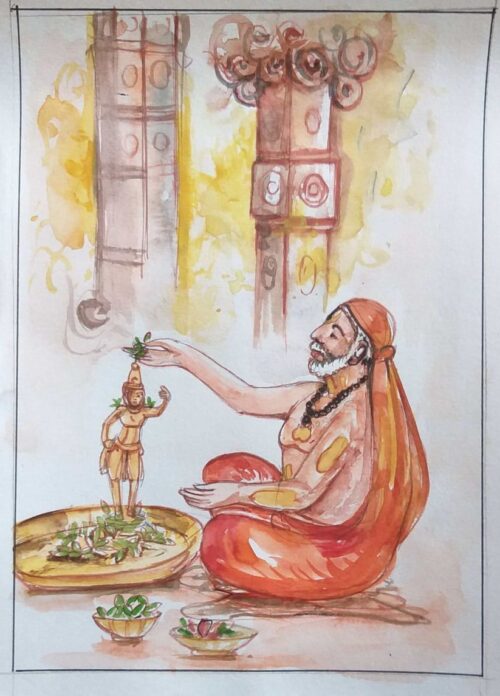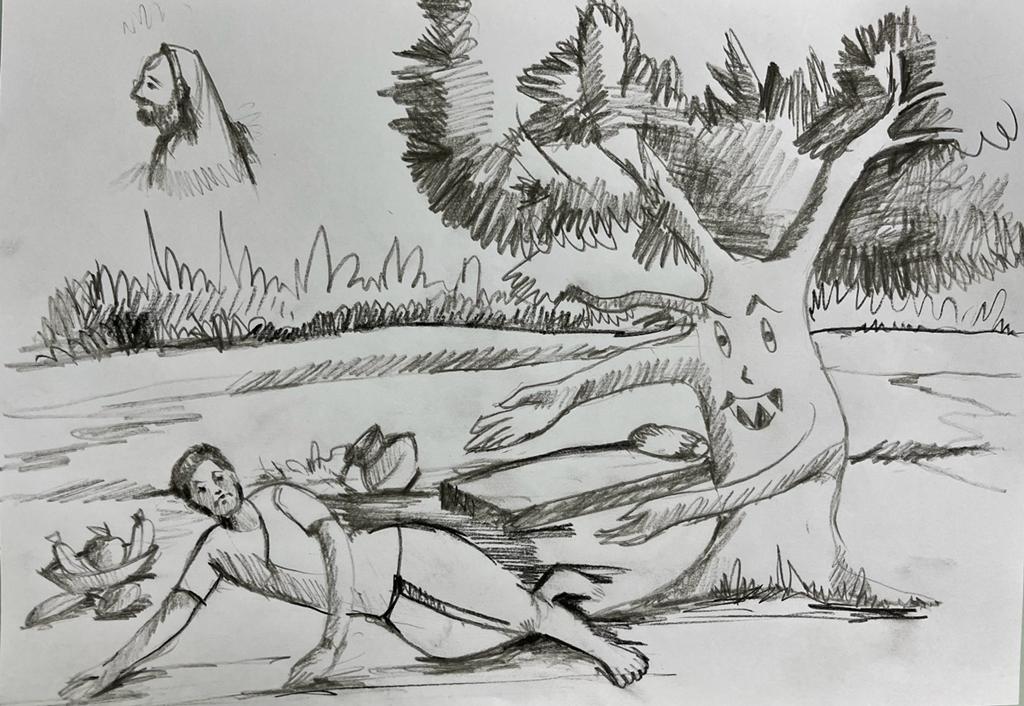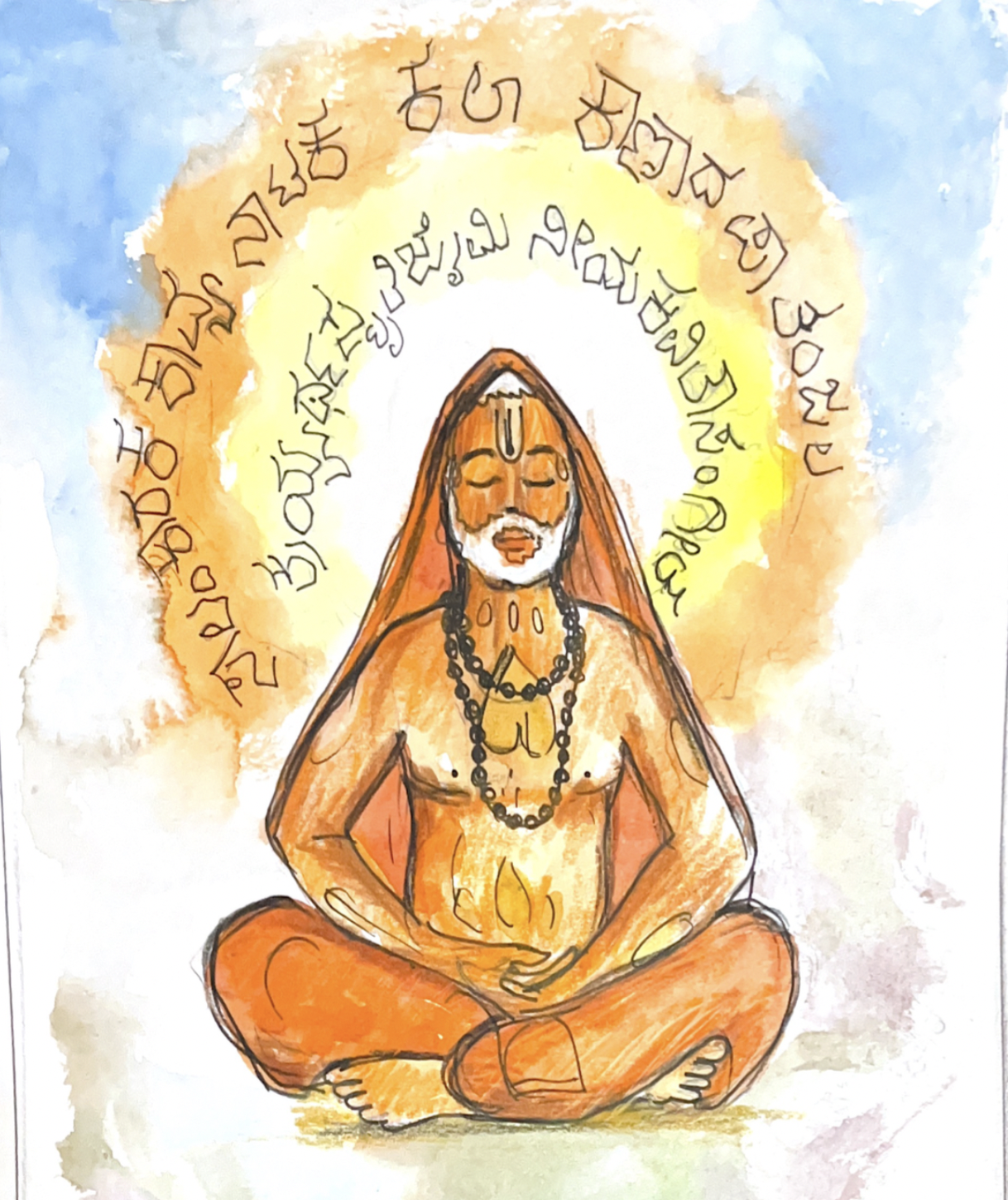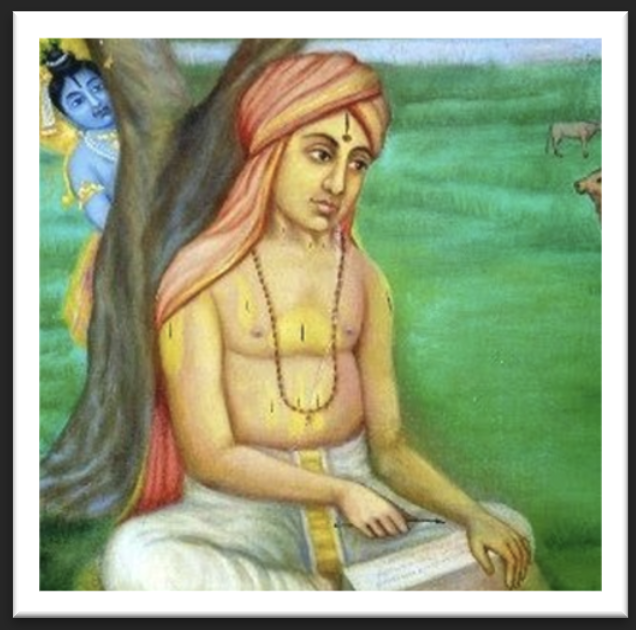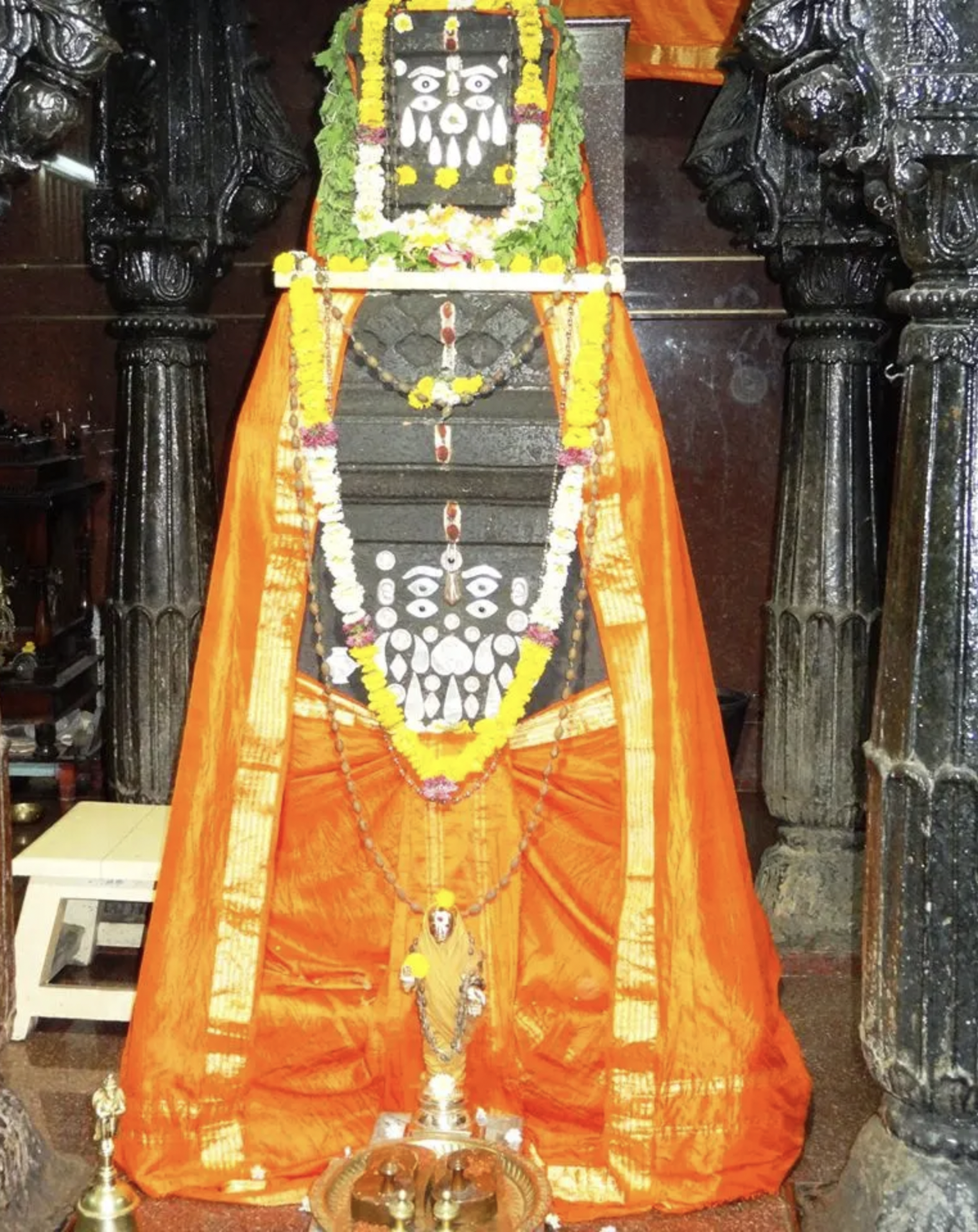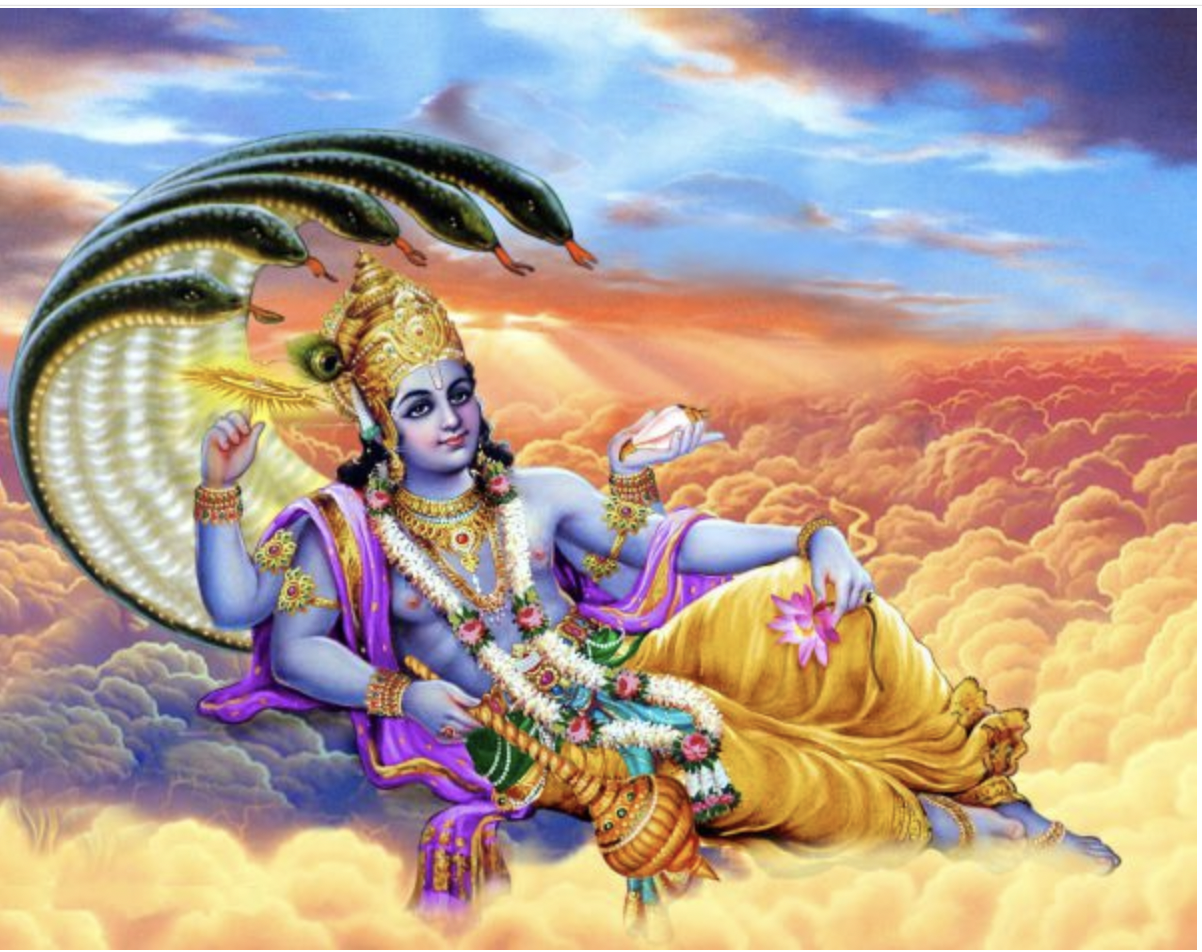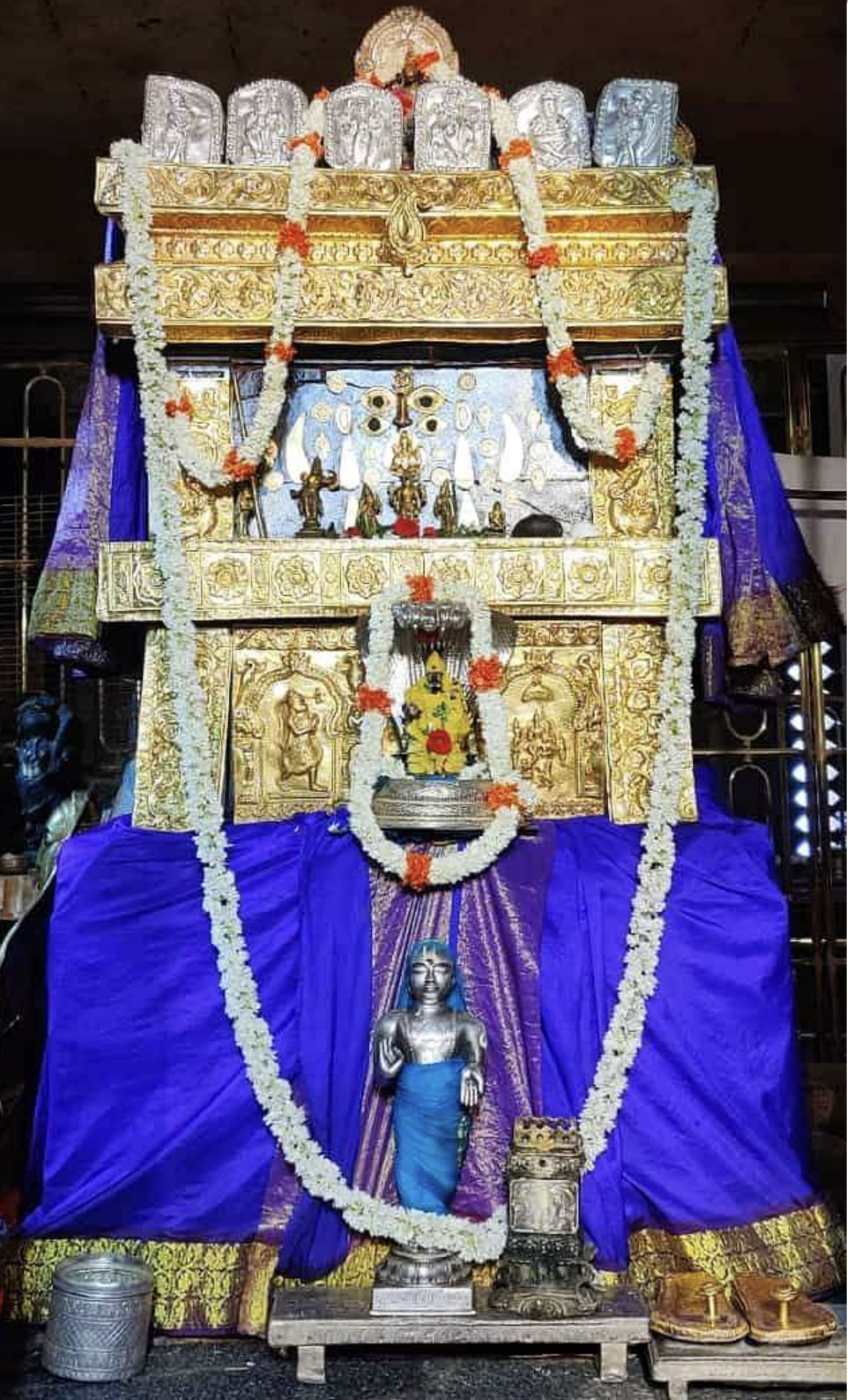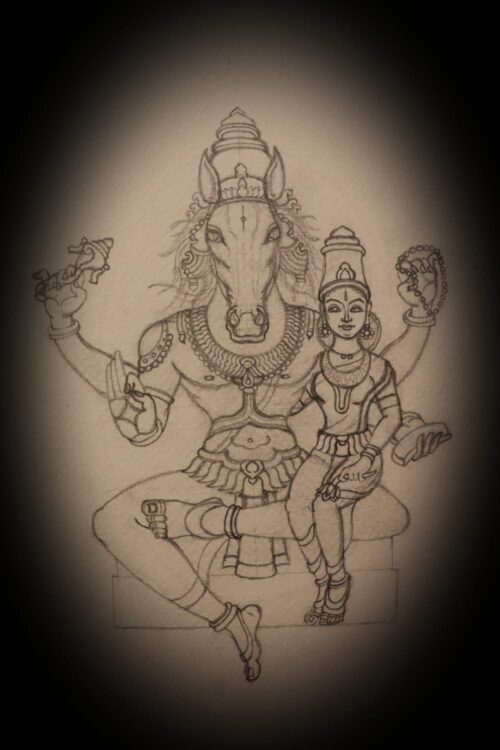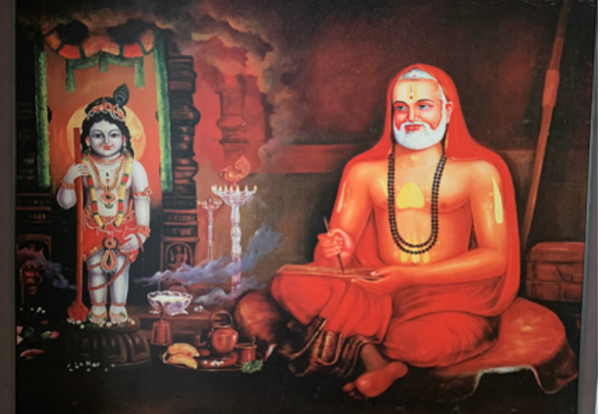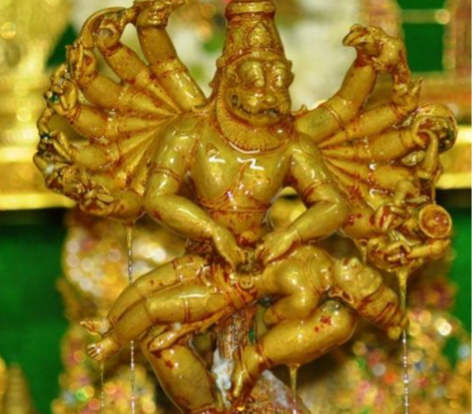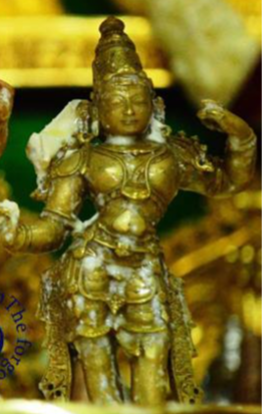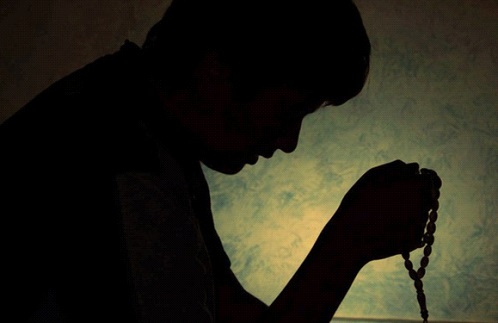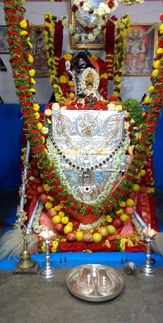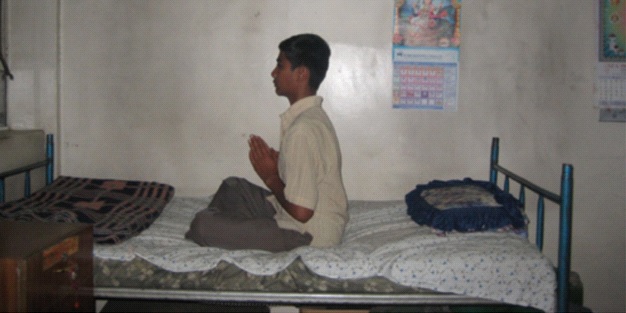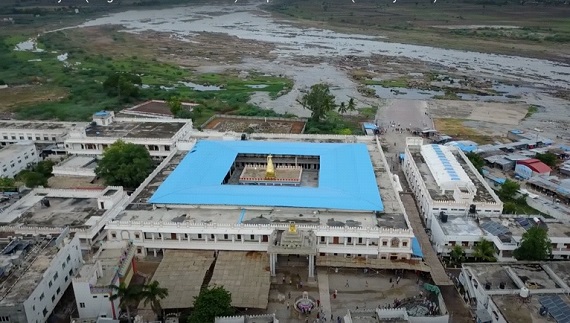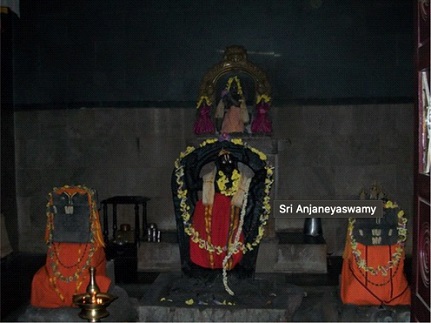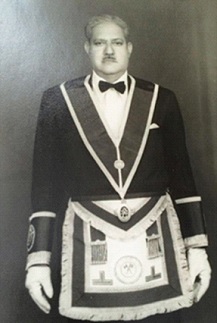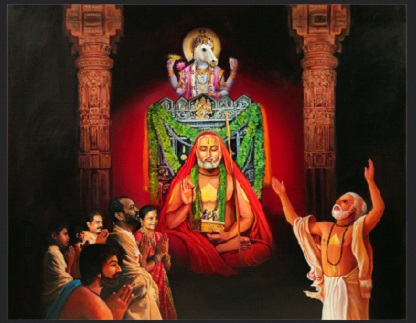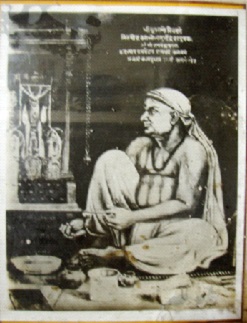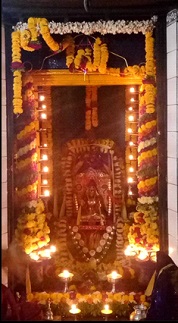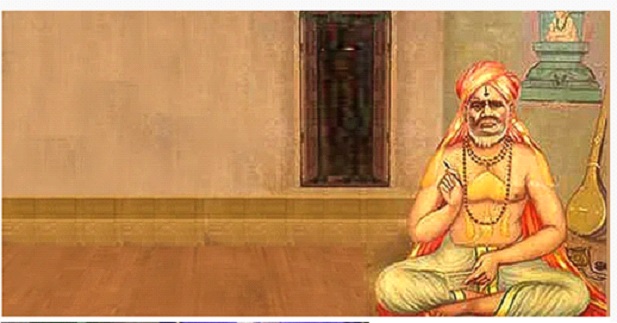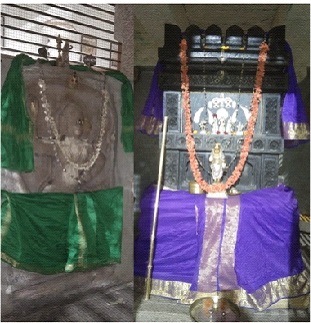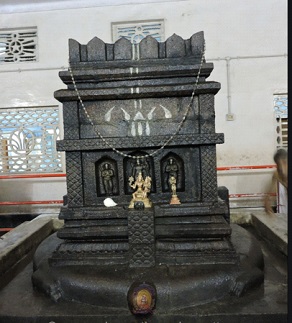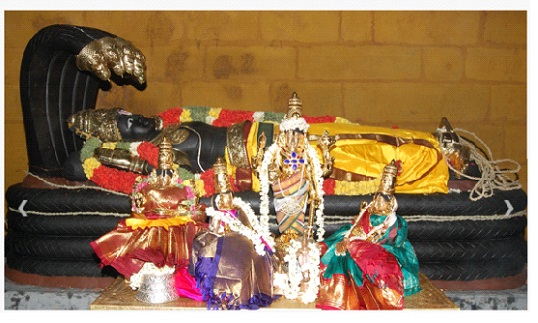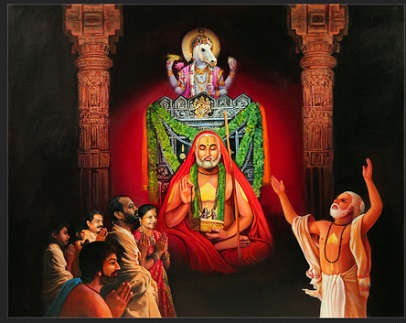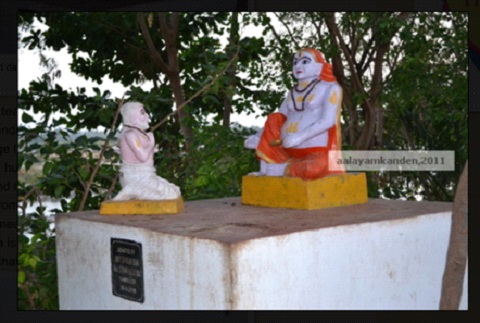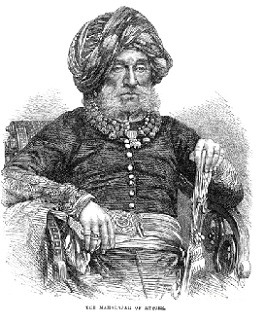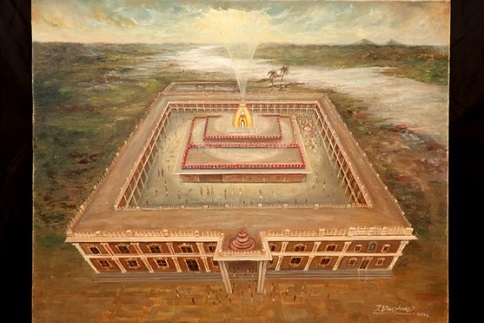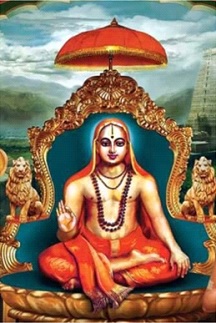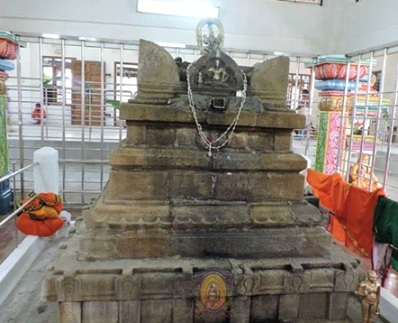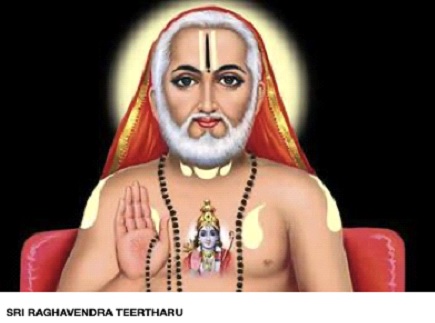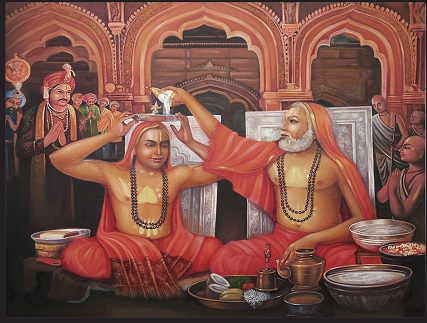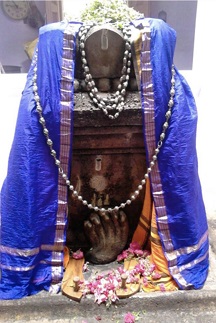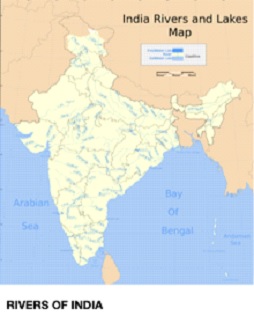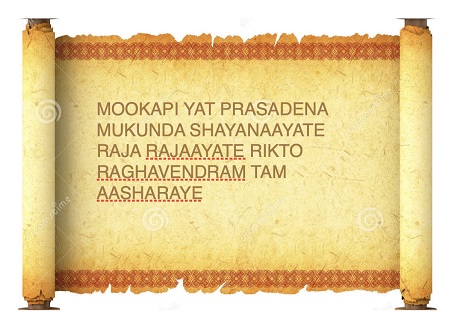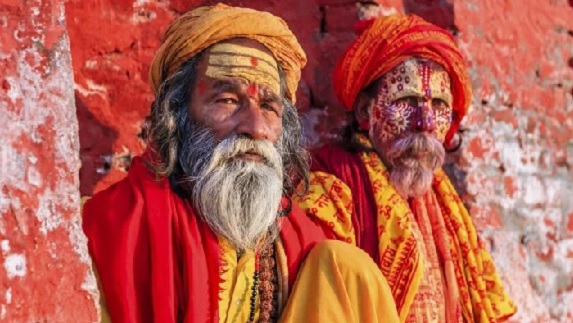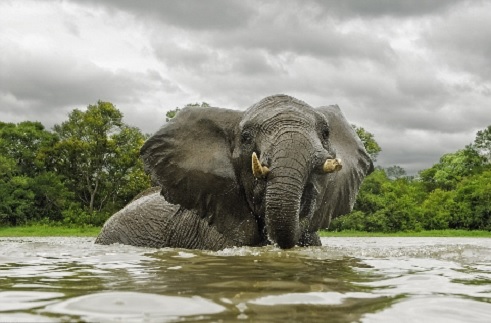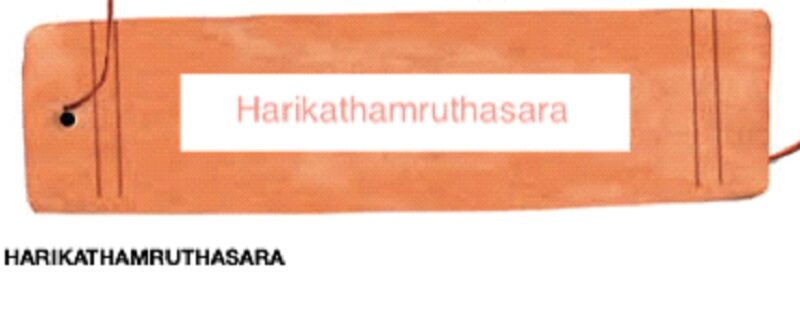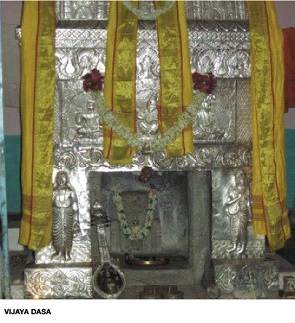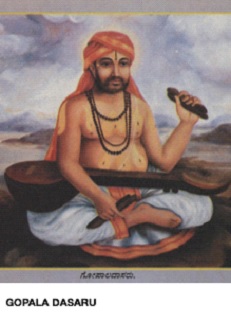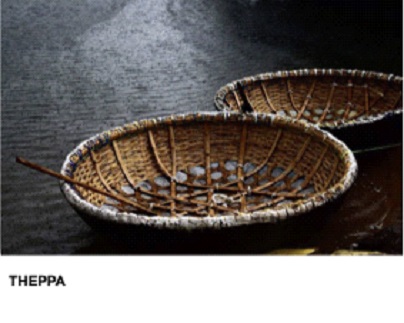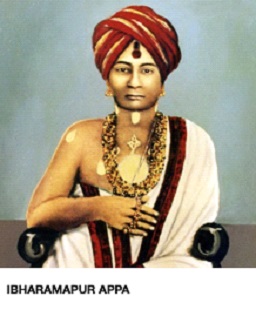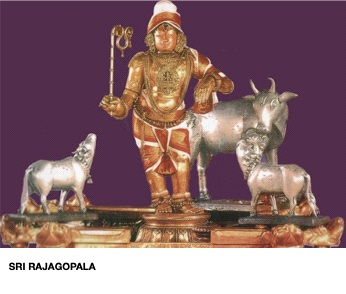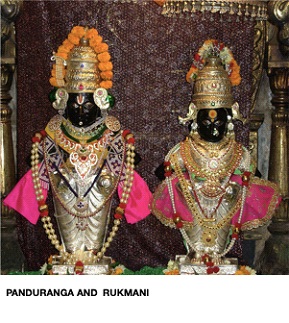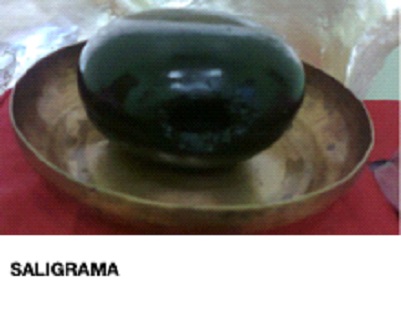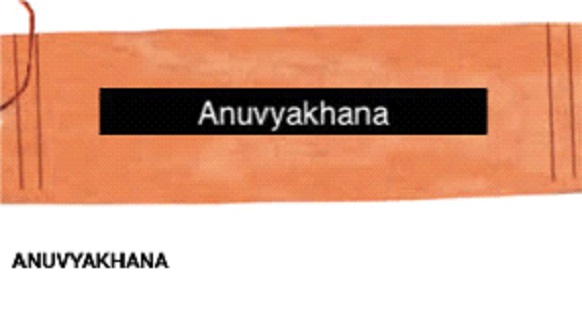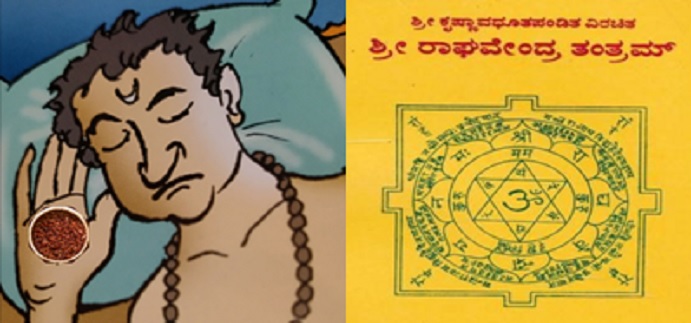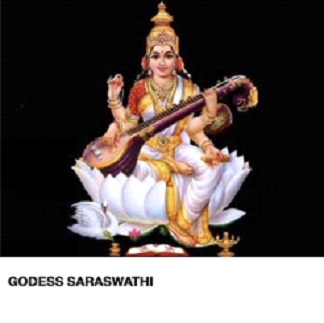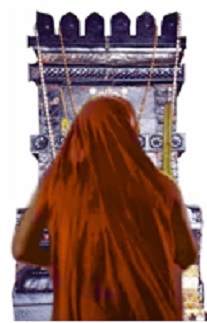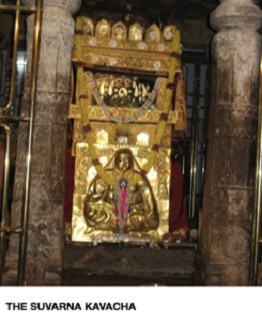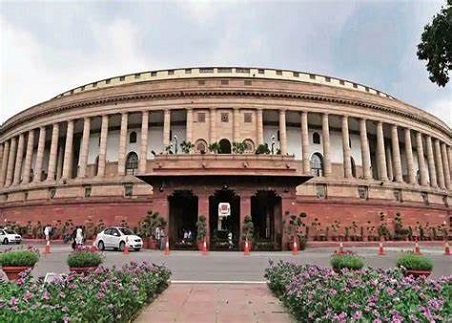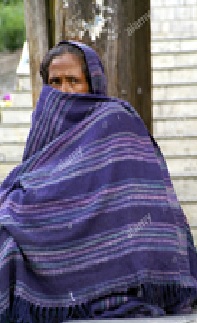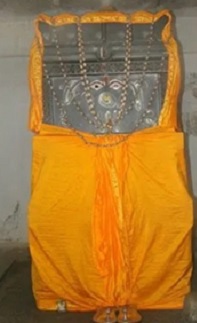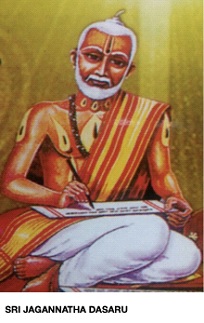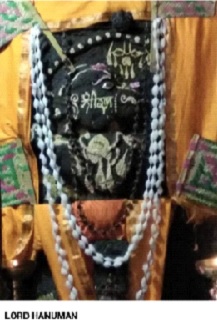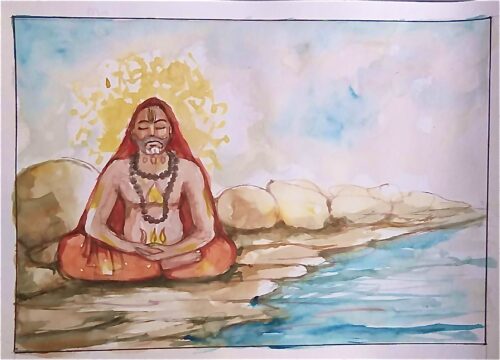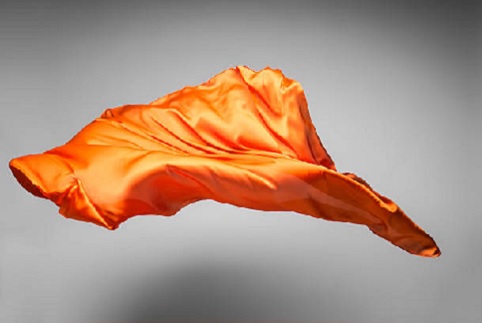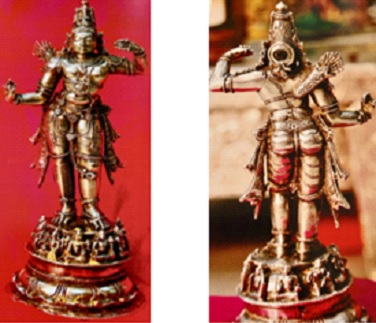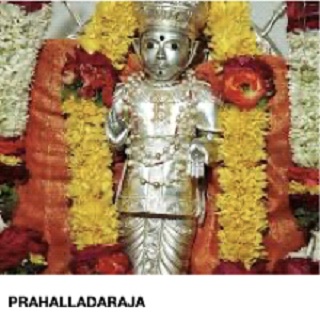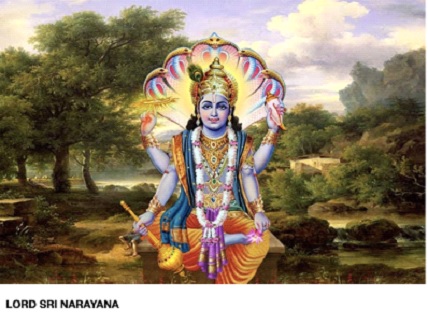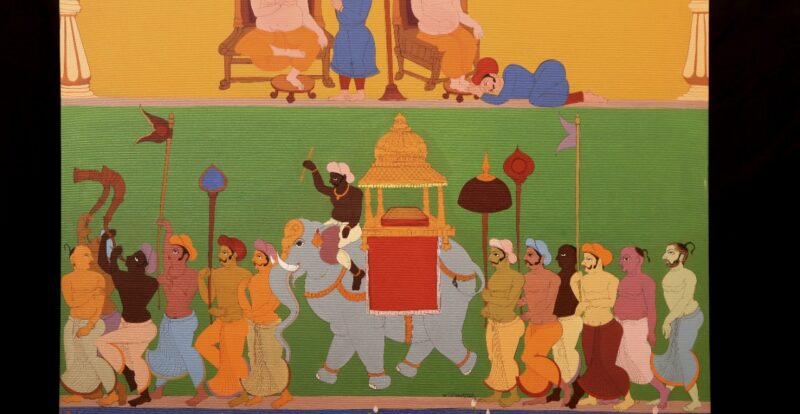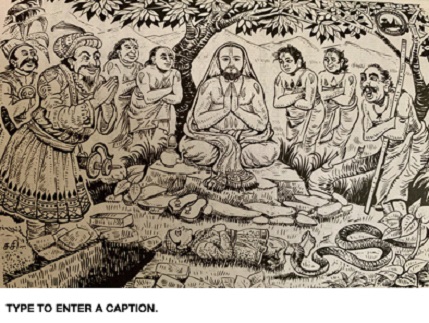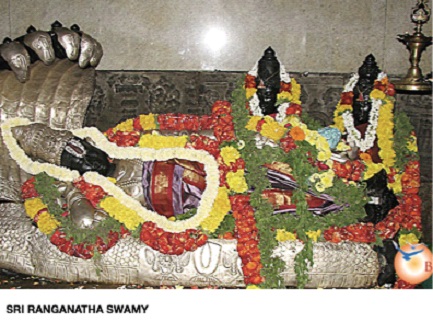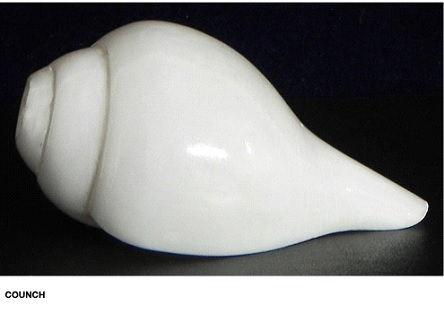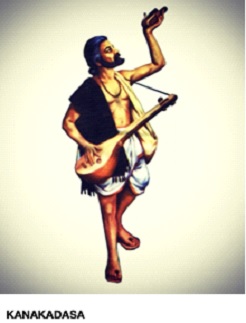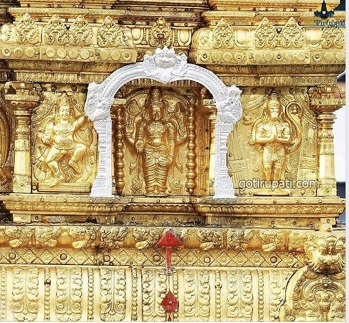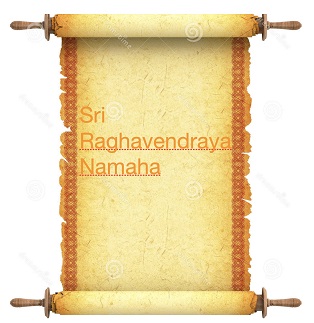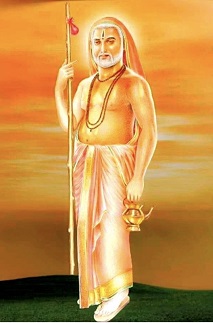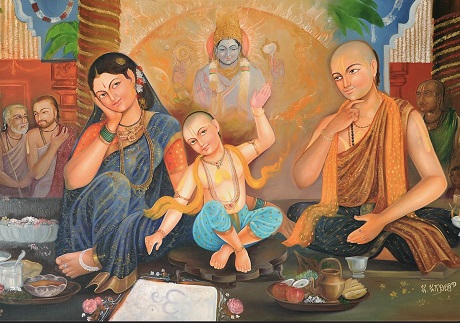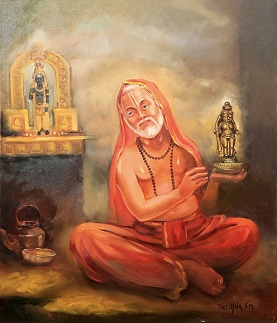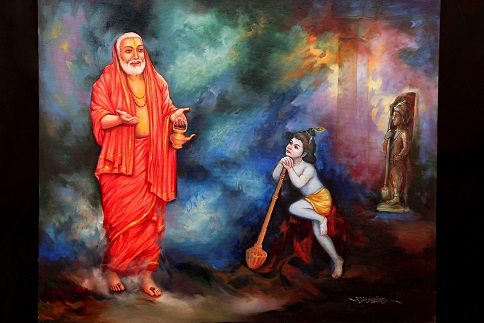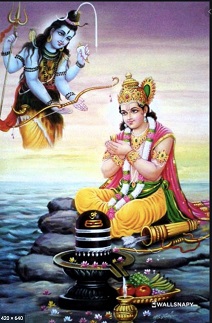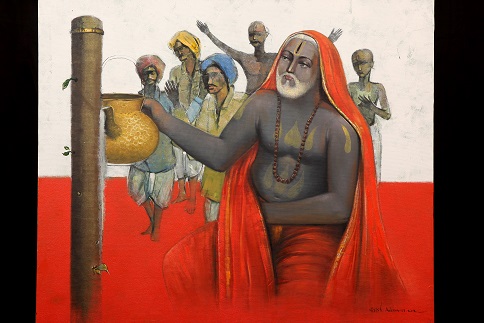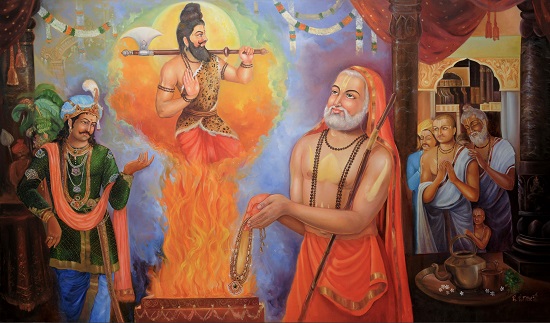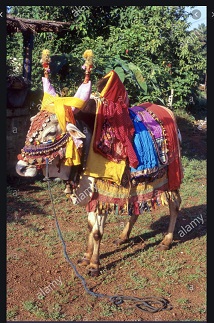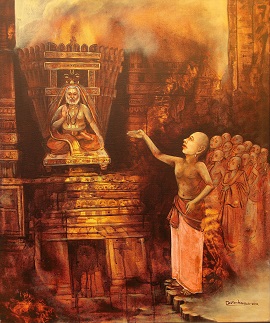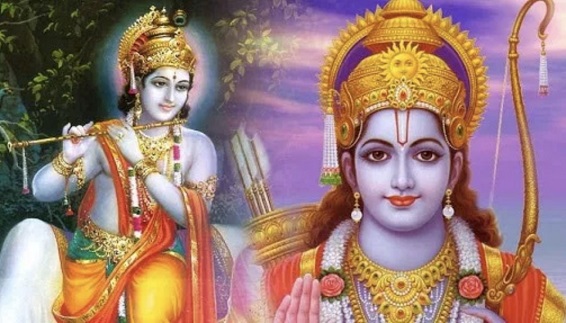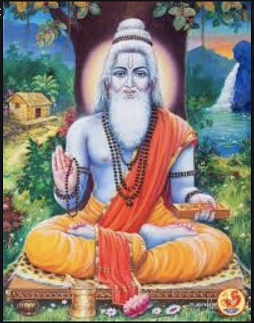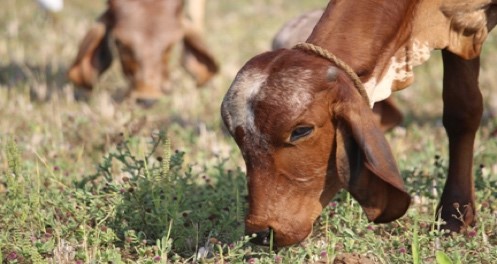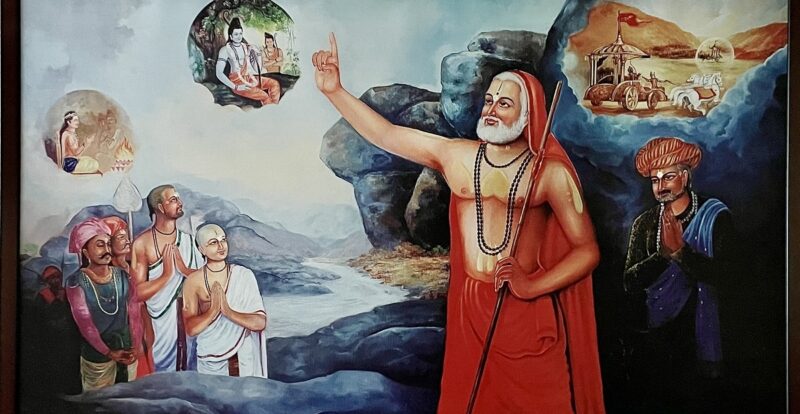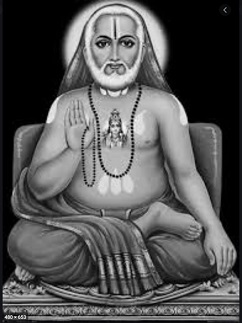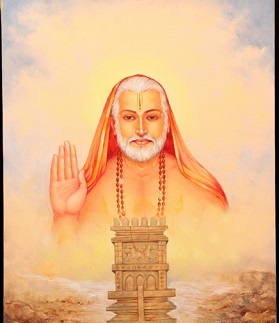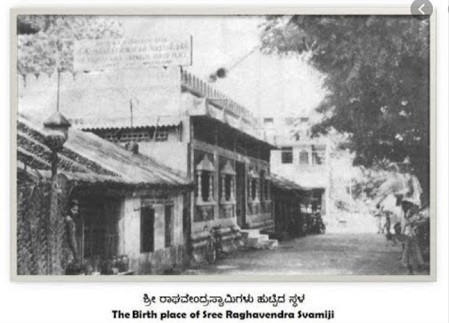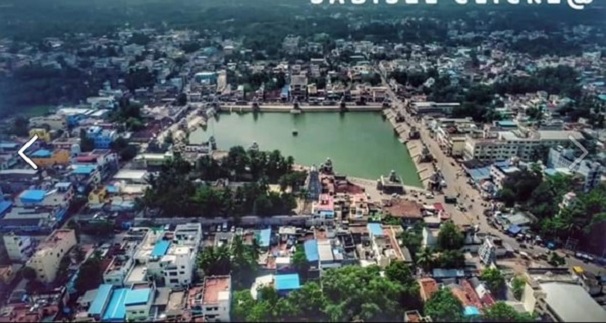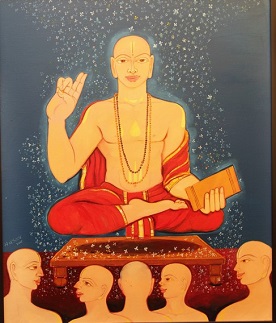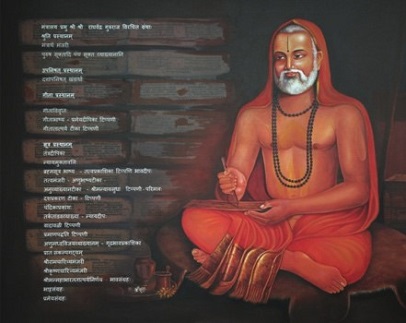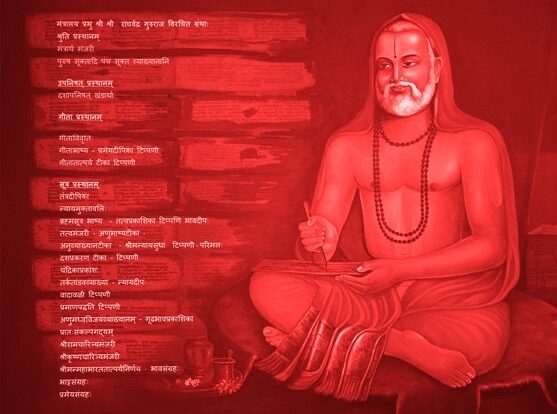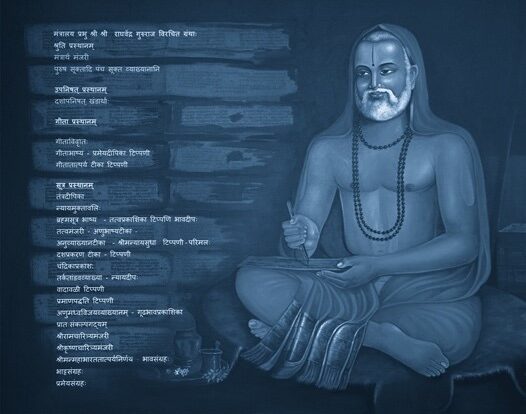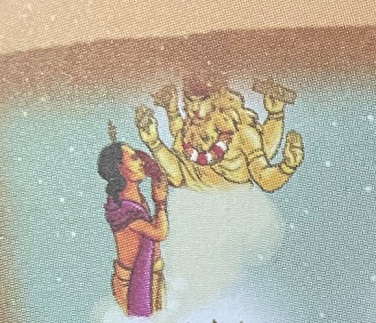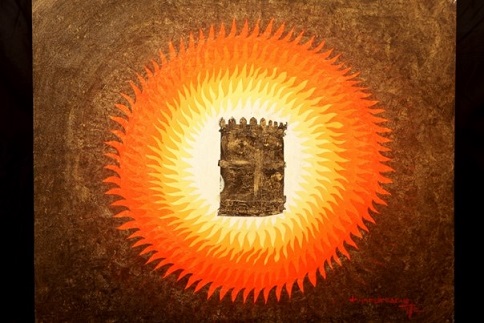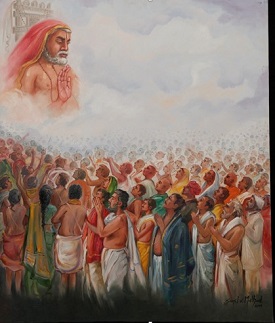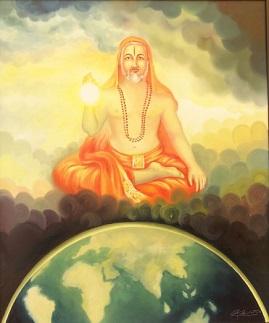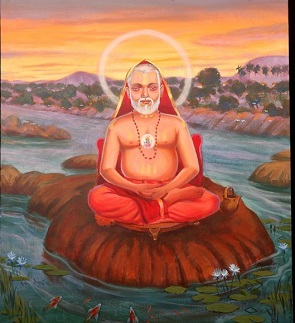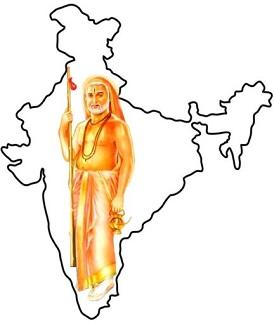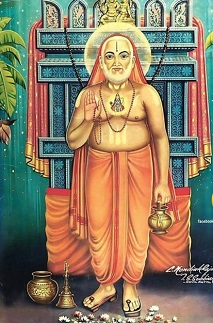OUR ARTICLES
Rayara Krupa brings to you over 300+ knowledge resources to give you the depth, dimension and experience of the inimitable RAYARU.
MahabashyaVenkatanathacharya
Sri SudhindraThirtharu the chief pontiff of MadhwasamsthanaKumbakonam was closely observing the progress of Sri Venkatanatha in his studies and was impressed with his knowledge, efforts, perseverance and commitment as a student. Debates between different schools of thought and sects were common in those days. On one such occasion there was a debate initiated between Mayavada
Music resounding in all Avataras
There are several attributes inherent in the soul which appears and re-appears in all the births. This is witnessed in Shankukarna carrying his love for music in all his subsequent births. It is evident here- Shankukarna gets engrossed in Devine Veena music of Goddess Sharadha makes it a cause for several births to serve the
Rayaru – The Sculptor
The family deity of Thimmanna Bhatta and Gopikamba was Lord Venkateshwara and the son born to them with his blessings was thus named Venkatanatha (Venkatanatha) who later on becomes Sri Raghavendra Tirtha. Sri Raghavendra Tirtha like all Madhwa Saints used to perform all pujas to Lord Venkateshwara at Tirumala and other destinations. The form of
Guru Rayaru Visits Kolhapur.
Sri Raghavendra Tirtha from Pandharpur travelled to Kolhapur, the town of lotus ponds. This town also carries high importance as Lord Krishna visited this town along with his brother Balarama. Guru Rayaru visited the temple of Goddess Mahalakshmi. This Goddess was dear to him as she was the wife of the Supreme and she had
Child Vasudeva kills Manimantha.
The Saint Sri Madhvacharya the divine personality being the Avatar of Lord Hanuman performed several feats in destroying the evil. The Saint in his childhood days was called Vasudeva. Even as a child he was demonstrating several miracles like bringing a dead log to life, blowing air to cure diseases, jumping from the top of
Akshaya Thritiya – it’s Significance
The Thritiya of the Vaishaka masa in the brighter half is observed as Akshaya Thritiya this day stands out to be a very important day in the Vaishnava practices there are several interesting events that is believed to have happened on this day. Holy Ganges having the touch of Lord Vishnus feet descended to the
The Dog – musical teacher.
This is a part of a real-life story of a Hindustani classical singer of world repute. The singer faced numerous obstacles in his journey including his father’s resistance for pursuing his musical career. The father gives up but suggests him to visit Mantralaya to do his seva. Accordingly the singer comes to Mantralaya for the
Lord Rama, His Aradhya Daiva
If you carefully notice the facade of Sri Raghavendra Swamy Brindavana you find Lord Rama In the top centre. It is said, The name Raghavendra has the credence for being suggested by Lord Rama himself to Sri Sudheendra tirtha. And hence Venkatanatha was given the name Sri Raghavendra Tirtha on taking up the Sanyasa. The
The Penance on Panchamukhi Anjaneya
Sri Raghavendra Thirtharu performed an intense penance for over 8 years in a cave near Mantralaya currently known as Panchamukhi. The penance was made to attain siddhi of Panchamukhi Anjaneya signifying the 5 Pranas – prana, vyana, apana, udana, samana, manifested by monkey, horse, boar, eagle, lion faces respectively. It is said that the control
Beware Of Fake Kalpavrukshas.
There is a story often told in the Gurukul tradition about the Gurus. The narrative is as below- A person walking in the desert feeling hot desperately wants to have a shade. He finds a tree far off and runs to rest under the tree. Relaxing for a few minutes he wished if water was
Sri Raghavendra Swamy Saptaha
Sri Raghavendra Swamy Saptaha means a week-long celebration starting from Palguna Shukla dweetya to Palguna Shukla Sapthami as per the panchanga of the Mutt. It was on Phalguna shulla dwithya of 1621 Sri Venkatanatha ascended to the peeta of Madhva Maha Samsthana, kumbakonam it was this day he was given sanysa ashrama by Sri Sudhendra teertha at the palace
Mastery in Subjects
Sri Raghavendra Tirtha was a Saint filled with immense knowledge on The Supreme and His creation – Materialistic and Non- Materialistic. Besides, being an Aporoksha gnana he was seen attributed with mastery over several subjects. A few subjects are mentioned by Sri Appanacharya in his composition – ‘Sri Raghavendra Mangalashtaka’. The subjects are coined into
Pranesha Vittala Dasa
Pranesha Vittala Dasa Pranesha Vittala Dasa (1736 – 1822) a popular Haridasa in the Dasa Koota was given the Ankita by Sri Jagannatha Dasa. He was earlier called Yogendra and lived with his two brothers Raghappa and Subbanna his father Tirikappa Kulkurni was a staunch devotee of Rayaru and often visited Mantralaya. He experienced a
Sri Varadendra Tirtha
Sri Balaramacharya on taking the ashrama from Sri Vasudheandra Tirtha was called Sri Varadendra Tirtha. He was an eminent Dwiatha Scholar of his times and was a contemporary of Sri Vijayadasa, Sri Gopaladasa and Sri Jaganathadasa, the highly evolved souls. Sri Pranesha Vittala Dasa, the deciple of Sri jaganathadasa was a follower of Sri Varadendra
Destination- Vaikunta
There is an episode in Padma Purana, Brahma Khanda chapter 3 featuring the benevolent qualities of a Brahmin Yogi Vaikunta. The most admirable quality of this tretha yug yogi was that he would send to Vaikunta any innocent and devoted person getting in contact with him. He used to bless them with complete deliverance i.e.,
Neerina Venkanna gets Sadgathi
Once Sri Raghavendra tirtha was camping in Chitradurga which was his favourite destination for the reason the Pandavas had worshipped Lord Hanuman’s idol with the tail having five bells here. The people of the town were amazed to witness a rare and unusual occurrence. One Neerina Venkanna engaged in fetching and serving water to the
Why Sri Guru Rayara Brindavana has two pairs of Eyes?
Not Many would have keenly noticed that the facade of Sri Guru Raghavendra Tirtha Brindavana has two pairs of eyes. Whoever has noticed might have pondered over this subject and the reason. The first pair of eyes on the top is believed to be of Vishesha Anugraha Drishti which means the Devine grace of the
Lord Hayagreeva – Horse Faced Avatar Of Lord Vishnu
Lord Hayagreeva, the horse head and human body form is the avatar of Akhilanda Koti Brahmanda Nayaka, Shriman Narayana. Lord Hayagreeva, the half-horse half-human form of Paramatma is the guru and devata for the Rujus. The Rujus are highly elevated Gods and include Brahma, vayu, latavya,etc totaling to hundred in numbers. Lord Brahma happens to be
The Legendary Veena Playing Family.
Playing Veena was a passion for Venkatanatha. He together with his brother Gururaja were trained by his father Veena Maestro Thimanna Bhatta. The father Thimanna was described having acquired proficiency as a boy in many sastras disputation in the Royal Court and in consequence to have receive a honorific Day Torch (Hagalu-Divatage). Music was a
Indu Enage Govinda
This is a song written by Sri Raghavendra Teertharu in praise of Lord Krishna at Udupi. It is opined that Rayaru used the Ankita nama of Venugopala in this song. This work is said to have been done when Rayaru camped in Udupi for ten Years. This composition belong to Bhairavi ragam and Janyam Ragam
Sri Shodasha Bahu Narasimha Swamy
A Grand Idol of Sri Shodasha Bahu Narasimha Swamy is worshipped in Sri Raghavendra Swamy Mutt. Being a devotee of Lord Narasimha, Pointif Sri Vibhudendra Teertha (1435-1495) spent many years in Ahobila worshipping the Lord. One day, he was performing his morning prayers near Bhavanaashini river, he came across a impressive and very rare icon of Narasimha with 16
Ford. C. Mega In Mantralaya.
During late seventies, one Ford C Mega wife of a major car maker was always feeling disturbed. She found no mental peace despite visiting The Vatican City. Her efforts in searching for peace continued but all in vain. Once, an employee of the car factory looking at her plight suggested to visit Mantralaya to pray Guru
Lord Jaya Rama Idol
Sri Raghavendra Swamy Mutt Worships Lord Moola Rama and different forms of Rama as the principal deities. An interesting Idol of Lord Jaya Rama is worshipped in the mutt. This stand-alone idol was made by Sri Jayatirtharu, the sixth pointif of Sri Madhva Samsthana during the period 1365- 1388. The idol was specifically made for
Rayaru feeds a devotee in silver plate
During the nineties Sri Ananda, a bank officer was very impulsive and made a quick trip to Mantralaya expecting to reach the destination by noon, have the Darshan of the Brindavan, consume the Prasadam and return the same day. However, he was delayed and could reach the temple at 2:30pm and by then the temple
Sarvasamarpana Gadya
As the name suggests, it is a prose of submission to the lord, done at the end of the day before the sleep. Sri Guru Raghavendra Tirtha has presented this to the mankind to adopt in one’s daily activity. Our ancient Yoga Sutras and modern science states that good thought generating process practiced before the
Prachina Brindavana at Budhikote
Budhikote is an ancient town dating back to 8th century, a province of the Kings of Bana Dynasty. This town has a fort and many temples dedicated to Lord Venugopala, Lord Hanuman and Lord Sugreeva, however, all in ruined state. This town is located 70 kilometres from Bangalore. The Mrithika Brindavana of Sri Raghavendra Tirtha
Prathaha Sankalpa Gadya
Prathaha Sankalpa Gadya is also called the morning prose of affirmation. This is as precious as a Gem authored by the great Saint Sri Guru Raghavendra Tirtha. It has minimal words yet it is a powerful composition. It is structured as a prose of one single sentence running into approximately five pages. It is a
Manchale Village – The Land of Saints
The village Manchale on the banks of river Tungabhadra is presumed to be reserved for Saints, as witnessed for the last 600 years. The Vijayanagar Empire was ruled by Devaraya II of the Sangama Dynasty from 1425-1446. He was amongst the most successful and eminent rulers, valuing the religious sentiments of his people. It is
Rayaru’s blessings on Vyasaraja Mutt priest
The head priest of Sri Vyasyaraj mutt at Coimbatore, a devoted Madhva Brahmin offered daily prayers and performing rituals to Lord Hanuman, Sri Vyasyaraja tirtha Brindavana and Sri Raghavendra Tirtha Brindavana. Though he worshipped the Mritika Brindavana, he would ensure a visit to Mantralaya moola Brindavana at least once in 5 years. Every time he
Prachina Brindavana At Coimbatore
With the acquisition of Thanjavur by the Marathas, several native Maharashtrians of all classes migrated to Thanjavur patronizing the Maratha kings. One Sri Sarkeel Govind Rao, an affluent Maratha Deshastha Madhava Brahmin from Tanjavur was a well-educated administrator well known in with the Royals. He was a philanthropist having donated large land holdings to Mutts
Guru Stotra – The Kannada version
The ‘Guru Stotra – Sri Poornabodha’ rendered by Sri Appannacharya is considered highly sacred as it is vetted by Guru Rayaru from the Brindavana. Millions of devotees recite this and have experienced the blessings of Guru Rayaru. The Guru stotra is in Sanskrit and learning is limited to a few. Hence, a need was felt
The Painting of Guru Rayaru
This is a rare piece of art depicting Sri Raghavendra Tirtha as picturised by an unknown artist. Guru Rayaru is seen engrossed in offering his prayers to Sri Moola Rama placed in an ornamental mantap. The art originally is a line drawing in black and white. The saint is depicted in a side posture sitting
Guru Rayaru arranges for Mrithika
Udagani is an ancient town on the banks of river Tungabhadra in Shikarapur, Shimoga district. It is 40 Km from Honnali. This old town Udagani is popular for being the birth place of the twelfth century poetess Akkamahadevi. This Shaiva pilgrim town is also popular for Sri Guru Raghavendra Tirtha Brindavana consecrated during 1672. The
Swamy Raya confesses his guilt
Guru Jagannatha Dasa earlier called Swamy Raayacharya as a gifted devotee of Guru Rayaru . He was privileged to see the Guru whenever he prayed. Once, he wished to get married but his financial condition caused a problem. Guru Rayaru appeared for him and informed to go to the king of Mysore and seek help.Accordingly
An active and yet, subtle and silent Pontiff
Sri Vasudhendra tirtha was the sixth pontiff of the mutt after Sri Raghavendra Tirtha. He was given the peeta by Sri Vadeendra Tirtha in 1750. He had his education under Sri Vadeendra Tirtha and after pontification spent all his time in Mantralaya Mutt engaged in japas and discourses. He is credited for initiating documentation of
King Bahalika – An earlier avatar of Guru Rayaru
King Shibi got his daughter Sunanda married to king Pratipa on the condition, that the son born to them shall be given to him for succeeding him. Thus, one of the three sons was given to King Shibi and this child was Bahalika. It is said by aparoksha gyanis that Sri Raghavendra tirtha was King
Glorifying innings of Sri Sumateendra Tirtha
Sri Sri Sumateendra Tirtha succeeded Sri Sooreendra Tirtha in the year 1692 and held the peetha till 1725. It was a very long innings of 33 years and the mutt was called Sri Sumeetendra Mutt synonymous to his name. His Poorvasharma name was Muddhukrishnacharya and he was the grandson of Sri Gururajacharya, the brother of
Guru Rayaru at Srirangam
Srirangam located near Tiruchirappalli is an important pilgrim destination for the Vaishnavas. It is one of the Swayambhu idols dating back to treta yuga. It is believed the king Ikshvaku brought this from satya loka to the earth and succeeded by his dynasty Kings up to Lord Rama. After killing the demon Ravana and coronating
Appanacharya – The noble soul was offered the Peetha
Appanacharya, is considered one of the most ardent disciples of Sri Raghavendra Tirtha and was intimately associated with him. Guru Rayaru’s stay in Appanacharya house at Bichale for over ten years speaks of the strong bondage between the two. As per Guru Rayaru’s advise, Appanacharya was again married to Ratnabai. As per their wish a
Guru Rayaru And Appanacharya
Appanacharya was born in 1593 to a wealthy Ramasubbharaya and Bagharithi Bai. He grew up to become a learned scholar with knowledge on Dwaitha Philosophy. He was based in Bichale on the banks of river Tungabhadra. He was from the Badadh family, which was instrumental in making the Sri Moola Rama Vighraha reach the hands
A Brahmin reborn as king
There was an aspiring Brahmin called Ramachandracharya who performed intense seva at Mantralaya. It went on for days, weeks and months but did not get any insights from Rayaru. Feeling highly disappointed, he went to Tirumala Lord Venkateshwara and complained against Sri Guru Rayaru, that he had not been blessed by him. Interestingly the same
Prayers of Sri Krishna Avadootha – Portion 1
The following is the text of the prayers submitted by Sri Krishna Avoodhata to Sri Guru Raghavendra Tirtha. This is as appearing in his book titled Sri Raghavendra Tantra, tenth Patala. The original text in Sanskrit is translated to Kannada by Sri Vedavyasyacharya. This is also referred to as Pradakshina Gadhyam.
Sri Vijeyandra Tirtha – Master Of 64 Arts
Sri Vijeyendra Tirtha, a Yathi Sreshtha and senior to the Guru of Guru Rayaru excelled in over 64 Kalas. Below is the list of Arts mastered by this inspiring Saint. 64 Kala (Activities in fine arts and crafts): 1 Music Singing 2 Music Instrument, Flute 3 Dance Nartana 4 Alekhya Drawing 5 VishEshaka ChEdyam Tilaka
Inspiring Works of Sri Vijayendra Tirtha
Sri Raghavendra Tirtha was a distinguished and celebrated scholar yet remained simple. He toiled for the knowledge and wisdom, deserving the blessings of his Guru. He always expressed high reverence for all his Gurus in his works. Sri Vijayendra Tirtha, a saint of extraordinary qualities was highly inspiring for Sri Guru Rayaru. Below is a
Guru Rayaru’s concern for his disciple’s works
The Madhva Maha Samsthana housed several poets , scholars and intellectuals of high fame led by Sri Raghavendra Tirtha. The works on Brahmasutras, Vedas, Upanishadas and spiritual subjects were always on-going. A complete harmony was observed in all the disciplines and functions of the Mutt. Sri Raghavendra Tirtha had taken a pledge to write commentaries
Guruparampara from Sri Raghavendra Teertharu
Relentless efforts were put by these Saints combating the evil effects of Kali. Several Rujus, Bhagavatars and great Souls took incarnation as Saints to offer the Divine Gnana for the evolving the souls. Sri Raghavendra Teertharu (1621-1671) Sri Yogindra Teertharu (1671-1688) Sri Sooreendra Teertharu (1688-1692) Sri Sumathindra Teertharu (1692-1725) Sir Upendra Teertharu (1725-1728) Sri Vadeendra
Sri Raghavendra Thirtharu – Information about Sanyasashrama
Divine intervention for sanyasa Deeksha – Goddess Saraswathi appears in dream of Venkatanatha Lord Rama suggest the name Sri Raghavendra to Sri Sudhindra Thirtharu Date Of Sanyasa Sweekara- 1621 AD (@ the age of 25th year), SAMVATSARA – DHRMATHI & Palguna – Shudha – Bidige Location of Brindavana- Manchale on the banks of Tungabhadra currently
Brindavana on the five-headed Serpent
After Sri Raghavendra Tirtharu entered into Brindavana at Mantralaya, the King of Tanjore, Sri Vijayaraghava Nayaka got into depression, he was feeling sad that Rayaru was missing in his life. He was feeling lonely and deserted. He spent much of his solitary time on the banks of Vadavuru where Rayaru performed his holy penance. While
Rayaru’s interpretation of rivers
Sri Raghavendra Teertharu has more than 50 Works to his credit, of which, Nadi Taratamya Stotra is a contribution on the Water Bodies of our Greater India. In this work, besides other information, he preaches about the Bhagavadroopa Chintane to be made in each of the waters during the prayers. Also mentioned hereunder, the temple
Surrender to Rayaru
MOOKAPI YAT PRASADENA MUKUNDA SHAYANAAYATE RAJA RAJAAYATE RIKTO RAGHAVENDRAM TAM AASHARAYE Sri Raghavendra Thirtharu is to this day, compared with Kalpvraksha and Kamdhenu – the celestial beings in the heaven for his generosity in granting boons and fulfilling the wishes. The devotees are expected to offer prayers with pure devotion and total surrender. Sri Narayanacharya
Ragappa Vadappa
Tungabhadra River is known for its sweet and soft waters. The river has such clear waters that one can see the rocky land beneath it and the flow of water constantly varies. As, the water flow was less, one could cross the river easily by walk. One such occasion, a deeply devoted Ananda Dasa, disciple
Elephant saves a life!
Rivers are a source of strength and relish a superior place in prayers and traditional practices. Perhaps, the one considered most divine and sacred, is taking a dip in the sanctified rivers. A belief that this would free our soul from the accrued sins and can release us from wrench of life. Many devotes took
Rayaru appreciates Harikathamruthasara
Jaganatha Dasaru, an ardent devote had the credit of having Darshan of Sri Raghavendra Teertharu and also engaging him in conversations very often whenever he wished for it. It is said he was Sri Sahlad,a the youngest brother of Prahalada in the Kritha Yuga. Jaganatha Dasa was earlier called Srinivasacharya and was given the Ankita
Vijaya Dasa gets Darshan of Gods
Sri Vijaya Dasa is one of the highly revered Hari Dasa the world has ever seen. An Aparoksha Gnani, he played an active role in propagating the Dvaitha philosophy. He considered Sri Guru Raghavendra as his Antharanga Guru, often visited Mantralaya and had the honor of seeing Rayaru and other Gods, live in the Brindavana.
Gopal Dasa sees Rayaru live..
Gopal Dasa earlier known as Bhaganna was a Hari Dasa of high rank and repute. He was the disciple of Vijaya Dasa and a staunch devotee of Sri Raghavendra Tirtharu. He had the privilege of seeing Sri Raghavendra Tirtharu live in the Brindavana at Mantralaya. Interestingly, he was the second Dasa after Vijayadasa to see
Rayaru avoids embarrassment to the Boatman.
Normally, brahmins practicing religion prefer to live on the riverbanks to perform their daily customary rituals. It is also a practice for the King to appoint boatman with Theppa to facilitate people to reach the other side. Venkatanatha once wished to cross the river and approached the boatman to drop him on the other bank
Saraswati returns pounded rice.
Sri Venkatanatha lived in an agrahara of Brahmins community where everyone lived in harmony. One caring for all and all caring for one. The women of one house used to share the work of the other house in the event of festivities and celebrations. On one such event Saraswati, wife of Venkatanatha, goes to the
Ibhramapura Appa.
Krishnacharya popularly known as Ibharamapura Appa hails from a small village which is located near Mantralaya. He was born by the grace and blessing of Rayaru. Once, the young Krishnacharya went away from home to a forsaken place and wept as he was scolded by his parents. An old man supposed to be Ashwatthama consoles
Rayaru visits Mannargudi .
Mannargudi is an ancient town in Tamilnadu, about 38 km from Kumbakonam frequented by the Vaishnava saints. This town has the most popular and greatly worshiped Sri Rajagopala temple. The presiding deity is the four-armed Vasudeva with Sreedevi and Bhoodevi on either side. It is a majestic 12 feet idol in the Sanctum Sanctorum. It
Rayaru at Pandarapur
Sri Raghavendra Teertharu visits Pandarapur Kshetra during 1660s and spends his time in the famous Sri Rukmini Panduranga Temple. Rayaru wishes to perform a music Seva to the lord and lifts his Veena to play. Just before he starts, he hears a melodious music from the string instrument played by none other than sage Narada.
Sri RaghavendraTantra.
Sri Raghavendra Tantra is written by Sandhur Krishnavadhoota, an eminent Sanskrit scholar of 19th century. This work was undertaken by the scholar upon the initiative of Sri Raghavendra Teertharu. The author being an ardent devotee of, was privileged to receive necessary Upadesha and blessings in his dream. This work carries other names like Siddhi Pradha
Kundan Thayaru blessed with a Siddhi.
One young Brahmin by name Kundan Thayaru lived near Udupi. He was jobless, wiling away his time with all unwanted vices. He never attempted to change his way of life. Years passed by and once and when he was walking by a street dog bit his leg severely causing severe pain. A saint passing by
Brahmin ties to loot, gets more
In a south Indian town, there was a young Brahmin too lazy to work, who spent his days maintaining falsehood. He felt the need of a marriage and was successful in getting a virtuous woman. She never allowed him to relax at home. Always forced him to go out, work and fetch the money. Unable
Rayaru’s unique working ways
One learned Brahmin and a liquor merchant both arrived at Mantralaya to perform the seva to Sri Guru Raghavendra Teertharu. The merchant had a few wishes to be fulfilled for which he did the seva in his own way, while the brahmin was involved in reading of ‘Anuvyakhana’ written by Sri Madhvacharya which happens to
Muddukrishna transforms Krishnavadhoota
Krishna fondly called muddu Krishna was the son of Venkataramanachar and Triveni, he was adopted by Bheemasenacharya and Venkamma. He grew up to become a learned Sanskrit scholar and an Asthana Vidwan in the court of Ghorpade Kingdom. He enjoyed all the worldly pleasures he aspired for and later realized the purpose of his life. He got
Goddess Saraswathy communicates to Sri Venkatanatha (IV)
Excerpts from Sri Raghavendra Vijaya written by Sri Narayanacharya and translated to English by Sri G.B. Joshi. In the sacred apartment of the priests and Maths devoted to rituals and rites as there would be no people, the continuous warbling of birds would be, I think, the discussion about the reality and unreality of the
Goddess Saraswathy communicates to Sri Venkatanatha (III)
Excerpts from Sri Raghavendra Vijaya written by Sri Narayanacharya and translated to English by Sri G.B. Joshi. Vedavyasa has appointed me to stay with those who perform the worship of Mula Ramadeva. It is also clear that the best of ascetics alone can perform the worship of Shri Rama. Therefore, I have been present with
Goddess Saraswathy communicates to Sri Venkatanatha (II)
Excerpts from Sri Raghavendra Vijaya written by Sri Narayanacharya and translated to English by Sri G.B. Joshi. Vijayendra Tirtha of incomparable wealth gave to me jewel box in the form of Tattvamanikya Peta. He gave me Nyaayamukta for the necklace. Whatever is fixed as the ornament of a woman, is given to me in the
Goddess Saraswathy communicates to Sri Venkatanatha (I)
Excerpts from Sri Raghavendra Vijaya written by Sri Narayanacharya and translated to English by Sri G.B. Joshi. Vedavyasa’s speech on Brahma Sutras is Kaamadhenu. From the milk of that cow, Bhashya on Sutras, Sri Madhwa sent me as a child. I attained my youth with the help of great disciples of Akshobhyateertha (Jayateertha). The whole
The Benagappa Episode.
During the time of Sri Bhuvanendra Teertharu as pontiff, one Sri Benagappa had an exclusive privilege of seeing Rayaru and chatting with him. This was a strange and an unusual boon though. Several devotees use to get answers from Rayaru through him. This went on for several days. The pontiff Sri Bhuvanendra Teertharu developed a
Making of The Suvarna Kavacha
It was during 1971, the 300th year celebration of Sri Raghavendra Swamy Aradhana, the pontiff Sri Sujayendra Teertharu wished the event to be celebrated in grandeur. It was his Sankalpa to make an offering of a Suvarna Kavacha also called golden shield to Guru Brindavana and he had another wish that contribution for the expensive
Madhava Rao Reborn
During early 1950s, Anwari Madhava Rao, an MP of Loksabha flew to New York on an official trip. He was with his team discussing and suddenly developed a severe chest pain, highly unbearable, and fell unconscious. He was rushed to the nearest hospital for critical care. On inspection, the doctors declared that there was no
A woman of poor virtue, surrenders
In Surapuram, a woman of poor integrity and character engaged in an unworthy profession was isolated with attack of Leprosy. Her ill health concerned her and she was also depressed with guilt of her past. The people of the village admonished her and sent her away. A thought crossed her mind that prayers, confession and
Sri Vyasa Tatvagna Teertha
Sri Vyasa Tatvagna Teerthar, considered an accomplished scholar of the 18th C, was based in the Gadwal kingdom. He had an in-depth learning of Nyaya Sudha, and always felt that he is an authority on the subject, and that, there was none to match his competency. He was of the firm opinion that his inferences
Rayaru listens to all utterances
Sri Raghavendra Teertharu is the only guru on whom, thousands of compositions are created by several Dasarus of different periods. One of them is Sri Jagannatha Dasaru from Manvi, a Dwaitha highly prolific scholar turned into a Dasa with Namaankitha- Jagannatha Vittala. Jagannatha Dasaru used to visit Mantralaya for worshipping Rayaru quite frequently but on
A unique idol of Lord Hanuman
Hathibelagal, an ancient town frequented by several seers is known for great spiritual seekers like Bilpatrachar, Arlikatte Narasimhachar and the like. There is a lord Hanuman id,ol concentrated by Sri Vyasaraja Teertharu, which is believed, that, another idol of the lord was done by Sri Raghavendra Teertharu. Also, Rayaru is said to have performed a
Rayaru opts for Tungabhadra
Sri Raghavendra Thirtharu selects the banks of river Tungabhadra as his final Abode, reasons being several as under – The river originates from the Sacred Hills of Varaha Parvatha which happens to be the point of penetration of Lord Varaha’s tusk when he was lifting the earth submerged by the devil Hiranyaksha. The water emanating
Rayaru on the banks of River Krishna
Flowing Rivers are always liked by the saints as they see a larger life force in it. There is always a memorable divine story attached to every river which the saints are cognizant of. Once Sri Raghavendra Teertharu visited Alur located currently in Kurnool District. He stayed on the banks of the quiet and gentle
The Magical Roof
Sri Raghavendra Teertharu with his entourage continued their long journey from one destination to the other, spreading the Madhwa Siddhantha. Their travel was filled with curious events and miracles. Once, on a sunny day, the group was travelling to Pandrapur by walk. There was a pregnant woman in the group and suddenly, she developed labor
Lord Digvijayarama Idol – A invaluable possession
Sri Raghavendra Swamy Mutt in its Heirloom has several sacred Idols carrying high spiritual value, which are priceless and have a curious origin. These include Sri Moola Rama, Sri Digvijayarama, Sri Jaya Rama, Sri Vaikunta Vasudeva, Sri Santhanagopalakrishna and Vyasa Mushty which are the Aasthana Prathimes of the Mutt. The Digvijayarama mounted on a Rajathapeeta
Prahalladaraja as Rayaru
Sri Raghavendra Teertharu is seen as one of the greatest saints in this Kaliyuga. His earlier birth as Sri Vyasaraja Teertha, Sri Bahalikaraja and Sri Prahalladaraja is undisputed as it is expressed by the divine personalities, in various citations. There is an incident, which makes it evident that Sri Prahalada raja and Sri Raghavendra Teertharu
Guruparampara upto Sri Raghavendra Thirtharu
The Dwaitha Philosophy also called in several names like Madhwa Philosophy, Madhwa Matta, Vyasa Matta etc., preaches the Doctrine Hari Sarvothama i.e. Lord Hari is the Supreme. It is said the humans gets the desired Moksha only by acquiring the required Gnana which is treasured in our Vedas, Upanishads, Puranas, Brahmasutras etc, which were made
Rayaru’s works on an Elephant procession
Sri Raghavendra Thirtharu engaged in several debates with Scholars of high repute from different schools of thought. In all these debates he was successful by virtue of his wisdom, in depth learning and convincing skills. On one occasion he was invited to participate in a debate by the King of Madurai Sri Tirumala Nayaka (1623-1659).
Buried boy revived back to life
Sri Raghavendra Thirtharu and his team were travelling in North Karnataka and reached a village called Krishnapura. It was scorching hot day, and all were resting at a place. On knowing that Rayaru is in the vicinity, the Nawab of Savanur comes walking and approaches Rayaru. He makes a humble submission to Rayaru that he
Rayaru Visits Srirangapatna
Sri Raghavendra Thirtharu visited several pilgrim destinations of Vaishnava importance. On one occasion, he visited Srirangapatna on the invitation of the then-King Doddadevaraja Wodeyar (1627-1673). The King was God fearing, respectful to saints and patronised all of them. His ancestors had the privilege of honouring Sri Vibudhendra Thirtharu, the popular Saint of the Madhwa Lineage.
Rayaru cleanses a Brahmin
After the visit to Rameswaram, Sri Raghavendra Thirtharu reaches the Banks of River Thamraparani. There in a Hamlet Kallidaikurichi he comes across a Brahmin very aggrieved, being outcasted and rejected by a group of Brahmins. He was rejected, it is said, as he had become impure for having deviated from traditional Brahmin practices, customs and
Mantrakshathe Turns Black
Once Sri Raghavendra Thirtharu accepts mustard seeds offered by a devoted Harijan. It was during Ashada of Chaturmasa period and as a customary practice, mustard seeds are prohibited in food preparations. Overruling the custom, Rayaru hands over the mustard seeds to the cook instructing him to use it in the preparation of the naivedhya to
Kanakadasa gets Moksha
Sri Raghavendra Thirtharu during one of his tours, was staying in Lord Hanuman Temple at Manvi in Raichur District. He was performing Chaturmasa vratha meaning he remained in the same place for four months. One day, an old Harijan comes to the temple and bows to Rayaru while standing at a distance. Rayaru on seeing,
Why Prahalada was reborn as Rayaru?
Thimanna Bhatta and Gopikamba constantly prayed lord Venkateshwara for a boy child, visited Tirumala the abode of lord Venkateshwara and stayed for long duration. The couple offered sevas during their pilgrimage. Thimanna Bhatta a scholar by himself used to do the parayana and deliver discourses on our epics and puranas. One evening Thimmana Bhatta delivered
Tanjore famine relief
King Vijayaraghava Nayaka ruled Tanjore Kingdom from 1634 to 1673. During 1640s his kingdom faced a severe drought with repeated failure of the monsoons. This calamity remained for many years causing panic to the King. He met Sri Raghavendra Thirtharu requesting for his intervention and solution to get back normalcy to the kingdom. He also
Sri Raghavendraya Namaha
Raghavendraya Namaha in Devanagari is an eight-syllable mantra meaning salutation to Sri Raghavendra. The name Raghavendra has the credence for being suggested by lord Rama himself to Sri Sudhindra Thirtharu. The word Raghava means descendants of Raghu Vamsha and Indra means Chief conveying the name of Lord Rama. Also, lord moola Rama is the Samsthana
Sri Raghavendra Thirtharu – Details of Purvashrama
Family Name- Shastika – Biga Mudra Family Great Grandfather- Veena Pandit Sri Krishna Bhatta taught playing veena to Sri Krishnadevaraya’s grandfather and he was blessed by Sri Vyasaraja Thirtharu Family traces in recent history- Mayuravarma of Kadamba dynasty had 60 Scholarly Brahmins family representing 14 Gotras of which Gautama Gotra was prominent one. Grandfather –
Venkatanatha – The spiritually inquisitive child
The child Venkatanatha born to Gopikamba and Thimanna Bhatta was brought up in a traditional manner, as customary in a Brahmin family. The child was born with the grace of lord Venkateshwara, and was noticed to be spiritually inquisitive. The child used to ask several questions to his father like the grown-ups on topics related
Santhana Gopal Krishna
Sri Raghavendra Tirtharu spent around 10 years in Udupi Kshetra and his stay at this place was very memorable. The place he stayed at Udupi was just opposite to the Lord Krishna Temple. The decade of his Sanyasa life spent in Udupi was very significant and is said to be memorable for it was at
Rayaru’s stay in Udupi
Udupi Kshetra is well known for the Lord Krishna Temple constructed by Sri Madhvacharya. It is here that the Madhva Philosophy is said to been initiated. It has the credibility of housing several Mutts and spiritual institutions including the renowned Ashtamutts. It has remained a centre of Spiritual learning for the last seven Centuries. Any
Rayaru’s thoughts on Brahmana Hathya
Sri Raghavendra Tirtharu traveled to different pilgrim destinations in his lifetime and made it a point to visit all the places visited by Lord Rama in South India. He used to engage in preaching of Dwaitha philosophy during his tour. Giving discourses on Vedas, Upanishads, Puranas, Ramayana, Mahabharata and other holy scriptures, was the norm.
Miracle at Arasangi
Sri Raghavendra Tirtharu during his Yatra visits Arasangi, a village in north Karnataka. A group of learned Brahmins meet him to express their grievance against the Desai who had withdrawn all the grants of lands given by his grandfather. Further they expressed that the Desai, an atheist had no trust in shastras or rituals performed
Jewel Back from Fire
Sri Raghavendra Tirtharu performs a severe penance and brings heavy rains for the Tanjore Region. This act of Rayaru brought a great relief to the grief stuck King Sri Vijayaraghava Nayaka. The King filled with joy presents an expensive golden necklace studded with rare and precious gems to Rayaru, as a thanksgiving for the divine
Indian Bull-Symbolic of Dharma
The Bull standing with its four limbs is considered to be symbolic of dharma. The four limbs represent the four Yugas – Sathya Yuga, Tretha Yuga, Dwaapara Yuga and Kali Yuga. It is said the Bull standing firmly with four legs conveys dharma is followed in its complete sense with no violation absolutely. This is
Guru Guna Sthavana
Guru Guna Sthavana is a devotional composition made by Sri Vadheendra Tirtharu in praise and honor of Sri Raghavendra Tirtharu. The poet Sri Vadheendra Tirtharu was the fifth pontiff of the mutt after Rayaru. He was also the great grandson of Sri Raghavendra Tirtharu. It is said he was two years old when Rayaru entered
Two Saints too great, indeed!
After Sri Sudheendra Tirtharu hands over the reigns of the mutt to Sri Raghavendra Tirtharu, one Sri Yadhavendra Tirtharu comes to the mutt. It is said, Sri Yadhavendra Tirtharu was given the Sanyasa by Sri Sudheendra Tirtharu before Sri Raghavendra Tirtharu. On arrival of Sri Yadhavendra Tirtharu a group of his disciples argued that their
Sacred Mother of Venkatanatha
Thimanna Bhatta and Gopikamba were blessed by lord Venkateshwara to have a boy child. Accordingly, Gopikamba conceived a child. She knew the boy in her womb would be someone incredible and he would become a Saint of the highest order. The soul selected this womb considering the purity of the lineage (Vamsha Shuddhi).The great grandfather
Lord VedaVyasa gets relief
The birth of child Venkatanatha with the blessings of Lord Venkateshwara was considered a grand event in Kaliyuga. The child born in a traditional Brahmin family was tutored and mentored by scholars including Sri Sudheendra Tirtharu. In his young age, Venkatanatha developed interest in learning Vedas, Upanishad, Brahmasutras Puranas, Shastras, music, playing veena and many
Asinchana- a virtue in Rayaru
Asinchana is the quality of a person not to indulge in collection or consolidation of any materialistic objects. It is one of the greatest virtues found in one in a billion. This rare quality was seen, early-on in Venkatanatha, even before he took on sainthood. They were frequently observing fasting with no regrets. It is
Sacred Stone of Brindavana
The Brindavana of Sri Raghavendra Tirtharu at Mantralaya is sculpted using hard black rock. It is called Krishna Shila, as it is dark in colour. Rayaru makes a specific selection of this rock stone for his Brindavana for a unique and interesting reason. He says the rock at Madhavaram, the neighboring village of Manchale, is
GURU RAGHAVENDRA SWAMY – A DIVINE & MAGNIFICENT SPIRTUAL FORCE
Guru Raghavendra Swamy has earned many magnificent titles, each one, describing some aspect of his greatness, his quintessential magical life force. Rarely in a lifetime and beyond, does one life create such waves of change, in-depth transformation and paves a niche path for human advancement. Over years, there is a significant amount of literature produced
GURU RAGHAVENDRA SWAMY –The miraculous HEALER from the SOUTH
In the Hindu philosophical and religious traditions, there are many sacred names that have been enigmatic, mystical and phenomenally great achievers. As a nation, we can be proud of the testimony we bear to having some of the world’s greatest souls, that have changed the course for mankind. One such name, we call even to
GURU RAGHAVENDRA SWAMY – REAL-LIFE STORY SERIES – I (Birth, Family and Early Years)
Guru Raghavendra Swamy was born Venkatanatha, the second son of Sri Thimanna Bhatta and Smt Gopikamaba in the year 1595, in the Phalguna month, in Bhuvanagiri, Tamil Nadu. Shri Thimmanna Bhatta was the son of Sri Kanakachala Bhatta and the grandson of Sri Krishna Bhatta, a Veena scholar in the court of King Krishnadevaraya. He
GURU RAGHAVENDRA SWAMY – REAL-LIFE STORY SERIES – II( Education and Learning)
Venkatanatha was a brilliant child, and as he grew was sent further to pursue higher education. He started his higher education in Kumbakonam, then, considered the seat of learning, with Sri Sudeendra Teertharu. He was an earnest student and believed in preparations, and dedicated to mastering all the subjects, he was taught. It is said
GURU RAGHAVENDRA SWAMY – REAL-LIFE STORY SERIES – III (Setting the path of Human Transformation)
Guru Raghavendra Swamy was a saint of the Madhwa philoshophy and sampradaya. Quintessentially, he preached the Dvaita Siddhantha, or Dualism, which emphasizes complete devotion and surrender to Lord Vishnu. A core system of belief, as established by the great Madhwacharya, based on the nine Prameyas or nine doctrines, which begin with Lord Vishnu being the
GURU RAGHAVENDRA SWAMY – A PRISTINE GATEWAY TO REACH THE SUPREME TRUTH
Guru Raghavendra Swamy’s metaphysical and physical presence in the holy land of Mantralayam, continues to inspire and invoke people onto righteous and virtuous paths, even to this day. They say that the number of people who believe in the magnificence and effulgence of this great Saint is only increasing by the day. Guru Raghavendra Swamy
GURU RAGHAVENDRA SWAMY – WRITINGS, LITERARY CREATION & WORKS OF ART – I
Raghavendra Swamy’s works – A Gateway to Bhakti Raghavendra Swamy is considered one of India’s greatest Saints of his times. He was a devout follower and a staunch believer in the miracles of Lord Sri Krishna. Raghavendra Swamy had diverse strengths and capabilities – he was a great scholar, a wonderful orator, a classical musician
GURU RAGHAVENDRA SWAMY – WRITINGS, LITERARY CREATION & WORKS OF ART – II
Contd. From PART I Raghavendra Swamy’s works – Simple to Experiential One of the classical features of his writings and oratory is the simplicity of rendition, the clarity of expression and the alluring theme flowing underneath, subtly, creating an overall appeal for the Lord. Raghavendra Swamy’s Geetartha Sangraha, also known as Geeta Vivrutti is a
GURU RAGHAVENDRA SWAMY – WRITINGS, LITERARY CREATION & WORKS OF ART – III
Continued from PART II Raghavendra Swamy’s works – A CHANNEL FOR DEVOTION Guru Raghavendra Swamy brought alive the classic scriptures, texts and sacred testaments of the Hindhu Madhwa legacy, through his writings, albeit in simple and lucid styles. This not only popularized the Classic works but also brought them out of the orthodox closets and
RAGHAVENDRA SWAMY – A ‘REINCARNATED’ DIVINE MESSENGER
It is believed that Lord Vishnu, the eternal symbol of infinitude, of the eternal Truth, the omniscient and Supreme Lord has taken several forms over the four YUGAS – KRITA YUGA, TRETA YUGA, DWAPARA YUGA AND THE KALI YUGA, to protect his creation. In the first three YUGAS, he took various incarnations or AVATARS to
‘THE GURU WHO DISPELS DARKNESS OF IGNORANCE’
GU, means darkness of ignorance and RU, means one who removes and therefore, a GURU is one who removes the darkness of ignorance. A GURU also signifies one who reveals the life targets, or goals to the disciple. There is another interesting connotation of the word GURU, where GU means – one who transcends the
GURU RAGHAVENDRA SWAMY – GURU, TEACHER, FATHER.
In your deepest moments of grief, and in moments of helplessness, a time when you might go weak and lose faith, strength and a possibility when you feel you have reached the end of a road, when you cannot go ahead, when you cannot see clearly into your future and life seems, bleak…a GURU, a
GURU RAGHAVENDRA SWAMY – THE UNIVERSAL SAINT.
Guru Raghavendra Swamy, is considered by some as a saint, others as God, some more as a scholar or a devotee. Universally, Guru Raghavendra Swamy is a saint-God, a human-par-excellence, a divine spirit that rose to high altitudes during his lifetime, just with his noble actions and the power of superior living. His name, his
RAYARU and TUNGABHADRA
The Tungabhadra river is formed from the confluence of the Tunga river and the Bhadra river, which flow down the Western Ghats in Karnataka. One of its primary tributaries connects it with the holy shrine of Mantralayam, along the Kurnool district in Andhra Pradesh. Over generations and decades, the pristine river Tungabhadra is synonymously associated
PILIGRIMAGES OF GURU RAGHAVENDRA SWAMY
Guru Raghavendra Swamy is considered a saint-God, a theologian and a scholar. Above all, a miraculous and benevolent seer who worked for the upliftment of human life. Sri Raghavendra Swamy started teaching Dvaita philosophy and Madhwacharya principles to all his disciples at a very young age. In the process, he also created several compositions praising
ABOUT THE SIGNIFICANCE OF MANTRALAYAM
Mantralayam is a pilgrim village located in Kurnool district in Andhra Pradesh, India. It lies on the banks of the river Tungabhadra on the borders, with the neighbouring state of Karnataka. The village is famous for the holy presence of the Vrindavana or the sacred burial of Guru Sri Raghavendra Swamy. Thousands of devotees visit
ABOUT THE ‘GREATNESS’ and ‘RELEVANCE’ OF GURU SHRI RAGHAVENDRA SWAMI in the 21st C (1595 – 1671)
Search for any aspect about Guru Sri Raghavendra Swamy’s life in Google as saint, scholar, theologian, mystic, reformer and you will find over 30lac search results for each search query , today. There is a significant and voluminous amount of literature, scholarly texts and authored titles which talk about the life and times, the significance,


